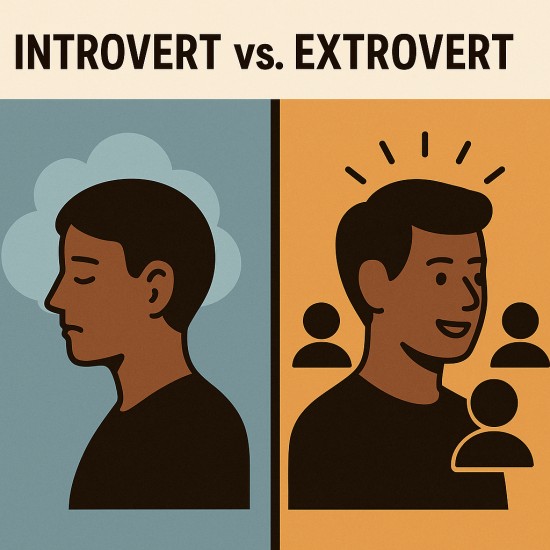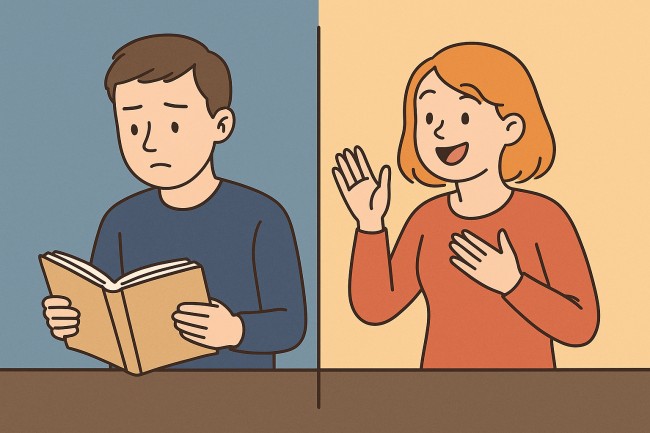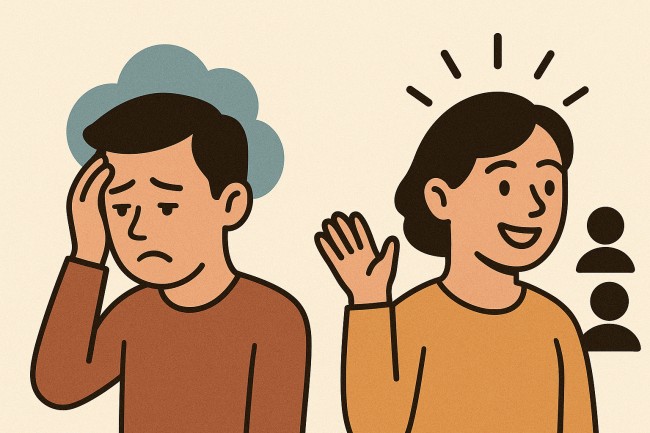Understanding how individuals react to the world around them starts with distinguishing between introverts and extroverts. These two personality orientations influence social interactions, energy levels, and decision-making styles.
Despite popular simplifications, they exist on a spectrum and reflect patterns in energy restoration and stimulus processing.
Here, in this article, we will discuss the key differences between introverts and extroverts, including traits, types, workplace behavior, brain science, and social dynamics. Let us get started without any ado!
Defining Introversion and Extroversion
Introversion refers to a personality orientation where internal thoughts take precedence over external stimulation. Introverts often prefer quiet spaces and find energy through solitary activities or limited social interaction.
In contrast, extroversion points to a tendency toward outward focus, where social environments and external stimuli serve as sources of energy and motivation.
Carl Jung first introduced the terms in the early 20th century. His work established the framework still used in psychology today. Though the theory evolved, the core idea remains: one orientation draws energy inward, while the other looks outward.
Introvert vs. Extrovert: The Differences
| Trait | Introvert | Extrovert |
| Energy Source | Recharges in solitude | Recharges through social interaction |
| Social Preference | Prefers small groups or alone time | Enjoys large groups and constant interaction |
| Communication | Thinks before speaking | Thinks while speaking |
| Work Style | Independent and focused | Collaborative and dynamic |
| Learning Style | Quiet reflection, written work | Group discussions, active participation |
| Leadership Approach | Calm, measured, detail-oriented | Energetic, motivational, people-driven |
| Stress Triggers | Overstimulation, noisy environments | Isolation, lack of interaction |
| Technology Use | Favors asynchronous tools like email | Prefers live chats and video meetings |
| Personality Spectrum | May lean deeply inward | Leans outward toward people and action |
Top 10 Characteristics of an Introvert
- Enjoys solitude – Finds energy in being alone rather than in social gatherings.
- Thinks before speaking – Processes thoughts internally before verbalizing.
- Prefers deep connections – Values close, meaningful relationships over broad social circles.
- Avoids attention – Dislikes being the center of attention in public or group settings.
- Excellent listeners – Tends to listen more than talk, offering thoughtful responses.
- Reflective and introspective – Spends time examining thoughts, feelings, and decisions.
- Low tolerance for stimulation – Feels drained by noise, crowds, and overstimulation.
- Independent worker – Excels in solitary work environments with minimal interruptions.
- Limited social energy – Can engage socially, but needs downtime to recover afterward.
- Observant and detail-focused – Notices subtleties others may overlook, often analyzing situations thoroughly.
Top 10 Characteristics of an Extrovert
- Energized by social interaction – Feels most alive in the presence of people and activity.
- Talks to think – Verbalizes ideas to clarify and understand thoughts.
- Outgoing and expressive – Comfortable initiating conversations and sharing openly.
- Enjoys group settings – Drawn to parties, events, and team-based environments.
- Quick decision-maker – Acts swiftly, often without extended internal deliberation.
- Comfortable with attention – Thrives when leading discussions or presenting publicly.
- Adapts to dynamic situations – Performs well under change or fast-paced conditions.
- Prefers collaboration – Enjoys brainstorming, teamwork, and peer interaction.
- Spontaneous and active – Seeks new experiences and thrives on movement.
- Highly expressive body language – Communicates with enthusiasm and gestures.
Types of Introverts
- Social Introvert – Prefers small groups or alone time but enjoys meaningful interaction on their terms.
- Thinking Introvert – Deeply introspective, often lost in thought and focused on internal creativity.
- Anxious Introvert – Feels nervous in social settings and may ruminate over past interactions.
- Restrained Introvert – Slow to warm up in new situations, prefers to observe before engaging.
- Creative Introvert – Draws inspiration from solitude, channeling it into art, music, writing, or design.
- Introspective Introvert – Constantly self-reflecting, seeking to understand motives and behaviors.
- Reserved Introvert – Quiet by nature, communicates best in close-knit circles or one-on-one conversations.
- Passive Introvert – Tends to go along with others’ plans without initiating social activities.
- Emotionally Sensitive Introvert – Deeply affected by feelings, both personal and others’ emotions.
- Cognitive Introvert – Highly analytical and enjoys intellectual exploration through reading or research.
Types of Extroverts
- Social Extrovert – Seeks constant interaction and thrives in crowds or large gatherings.
- Expressive Extrovert – Openly shares thoughts and emotions, often energetic in expression.
- Adventurous Extrovert – Craves excitement, new experiences, and spontaneous activities.
- Assertive Extrovert – Takes charge in situations, confident in decision-making and leadership.
- Entertaining Extrovert – Enjoys performing, storytelling, and keeping others engaged.
- Supportive Extrovert – Draws energy from helping, motivating, or encouraging others.
- Persuasive Extrovert – Strong in communication, excels in debates, sales, and negotiation.
- High-Stimulation Extrovert – Enjoys multitasking, dynamic environments, and sensory input.
- Optimistic Extrovert – Maintains a positive outlook, often uplifting social dynamics.
- Strategic Extrovert – Leverages social networks to achieve goals and influence outcomes.

Core Behavioral Differences
Social preferences differ significantly. Extroverts gravitate toward group settings, thrive in conversation, and often feel depleted when isolated. Introverts prefer small gatherings or solo engagement. Too much interaction drains them, requiring downtime to recharge.
Communication style also reveals contrast. Extroverts tend to think out loud, processing ideas through dialogue. Introverts process thoughts internally before speaking, leading to measured and thoughtful responses. These patterns affect how individuals perform in meetings, classrooms, or collaborative projects.
Decision-making differs, too. Extroverts often make quick choices based on available input and thrive under pressure. Introverts pause, analyze, and consider multiple outcomes before finalizing decisions.
Brain Function and Biological Influences
Scientific studies identify neurological differences that align with these personality types. Dopamine, a neurotransmitter associated with pleasure and reward, plays a central role.
Extroverts show a more active dopamine response, especially in stimulating situations. That response motivates them to seek more interaction and excitement.
Introverts display a more balanced or even subdued dopamine reaction. Too much stimulation triggers fatigue or stress. Their brains rely more on acetylcholine, which supports introspection, sustained attention, and a sense of contentment through reflection.
Brain imaging confirms structural differences. For instance, introverts exhibit more activity in the prefrontal cortex, the area involved in planning and decision-making. Extroverts show higher activity in the amygdala, which processes emotional responses, especially related to social interaction.
Energy Dynamics and Social Recovery
Energy management represents a defining contrast. Extroverts replenish energy through external activities like networking, events, or group challenges. They lose energy when isolated. Social environments act like fuel.
Introverts require solitude or quiet to recover. Extended engagement exhausts them. Silence, creative outlets, or one-on-one conversations restore their energy. That difference is not about liking or disliking people, but about stimulus tolerance and restoration patterns.
Workplace Dynamics
Professional environments highlight personality differences sharply. Extroverts excel in team-based roles, open office layouts, and high-engagement tasks. They speak confidently in meetings and often assume leadership positions by default.
Introverts contribute value in focused, independent work. Deep research, writing, and problem-solving benefit from their approach.
While they may not dominate group discussions, they often produce thoughtful insights. Many modern workplaces recognize these contributions and now offer quiet zones or flexible schedules to support varying productivity styles.
Misalignment occurs when environments reward loud participation over thoughtful contribution. Organizations that prioritize both communication and contemplation foster better performance from all types.
Learning Styles and Academic Preferences
Educational settings expose how differently students respond to structure and stimulus. Extroverts learn well through collaboration, group discussions, and active participation. They benefit from verbal repetition and interactive feedback.
Introverts absorb material better through quiet study, reflective writing, and internalization. Long-form content, independent research, and visual aids align with their learning style. They often perform well on tasks requiring concentration and long-term analysis.
Balanced classrooms allow multiple formats—group projects for extroverts, self-paced modules for introverts. Flexible assessment structures offer equal opportunity to excel.
Technology and Social Interaction
Digital communication channels create different engagement pathways. Extroverts enjoy video calls, real-time chats, and social media interactions. These tools mirror in-person dialogue and keep their energy flowing.
Introverts prefer asynchronous communication. Email, messaging apps, or project boards allow time to compose responses. They engage on social media, but often post less frequently and with more intent. Online platforms enable them to set boundaries and choose when to participate.
Tech solutions tailored to both groups improve collaboration. Video meetings with mute options, message boards, or shared docs help balance engagement across the spectrum.
Myths and Misunderstandings
Common stereotypes distort understanding. Introverts are often labeled antisocial, shy, or withdrawn. In reality, many form deep connections, engage in social activities, and lead with quiet confidence.
Extroverts are sometimes viewed as superficial or overly dominant. These impressions overlook their enthusiasm, initiative, and willingness to lead. Both orientations carry strengths and challenges.
Mislabeling leads to skewed expectations. Introverts may feel pressure to “open up,” while extroverts might face criticism for expressing thoughts freely. Respecting different social rhythms helps build more inclusive environments.
Ambiverts: The Middle Ground
Some individuals exhibit traits from both sides. Known as ambiverts, they adjust behavior depending on context. They may enjoy public speaking but crave solitude afterward. They switch between roles based on needs, people, and settings.
Ambiverts possess adaptability. In teams, they listen and engage. In solo tasks, they focus deeply. Flexibility makes them effective collaborators, leaders, and communicators.
Understanding ambiversion reshapes the binary model. Personality exists on a continuum. Labels help describe tendencies, not box individuals into rigid categories.
Cultural Influence on Personality Expression
Cultural expectations shape how introversion and extroversion manifest. Western societies often favor extroverted traits—assertiveness, spontaneity, and outward confidence. In contrast, Eastern cultures may elevate introspection, respect for silence, and measured responses.
Social reward systems reflect these values. Classrooms, boardrooms, and media amplify voices aligned with cultural ideals. Those outside the expected behavior range face added pressure to conform.
Cultural awareness improves interaction and support across settings. Recognizing personality orientation without bias promotes respect in global teams and diverse classrooms.
Impact on Relationships
Relationship dynamics shift based on personality orientation. Extrovert-extrovert pairs may enjoy constant activity and shared social calendars. Introvert-introvert pairs tend to find comfort in calm routines, quiet evenings, and shared understanding.
When paired together, introvert-extrovert relationships require balance. Each partner adjusts expectations. The extrovert may reduce social frequency. The introvert may join more activities. Communication, patience, and space form the foundation for such bonds.
Respecting each other’s recharge methods prevents tension. Knowing when to engage or withdraw strengthens long-term harmony.

Leadership Styles and Influence
Leadership expression varies significantly. Extroverted leaders speak with confidence, energize teams, and thrive in fast-paced environments. Their charisma often attracts attention and motivates action.
Introverted leaders take a quieter route. They listen intently, prepare thoroughly, and build strong one-on-one relationships. They may delegate with precision and focus on deep execution over quick wins.
Both styles succeed when aligned with organizational needs. Matching a leader’s personality with team culture improves cohesion, productivity, and morale.
Mental Health and Stress Response
Stress triggers differ. Extroverts may feel agitated when isolated for long periods. Lack of interaction can lead to restlessness or decreased motivation. Structured routines and social opportunities improve their emotional balance.
Introverts may become overwhelmed by constant noise or unplanned interactions. Stress surfaces as fatigue, anxiety, or withdrawal. They benefit from personal space, time-blocked solitude, and clear communication.
Understanding these needs aids emotional well-being. Tailored environments, realistic expectations, and supportive networks reduce burnout across the spectrum.
Parenting and Child Development
Children show personality patterns early. Some seek friends and playgrounds. Others prefer books, puzzles, or imaginative play. Recognizing these cues helps guide development without forcing change.
Parents and educators often push children toward extroversion, assuming it’s more socially acceptable. Encouraging authentic growth proves more effective. Introverted children thrive in calm, consistent settings. Extroverted ones flourish with activity and exploration.
Balanced upbringing nurtures confidence. Activities, routines, and expectations built around the child’s orientation lead to stronger self-awareness.
Introvert vs. Extrovert Quiz
Answer the following questions by choosing the option that best reflects your natural preference. Tally your responses to determine your result.
| Question | Option A (Introvert) | Option B (Extrovert) |
| 1. Free evening | Stay in with a book or show | Call friends and plan a night out |
| 2. Meetings | Prefer to listen and take notes | Speak up and share frequently |
| 3. Social events | Feel drained afterward | Feel energized and ready for more |
| 4. Workspace | Quiet and private | Open and collaborative |
| 5. Decision-making | Reflect and analyze before acting | Decide quickly based on discussion |
| 6. Communication | Email or text, with time to think | Phone calls or in-person chats |
| 7. Weekend plan | One-on-one time or solo activities | Packed schedule full of social plans |
| 8. Problem-solving | Internal processing, solo research | Brainstorming with others |
| 9. New situations | Observe cautiously first | Dive in and adapt quickly |
| 10. Recharging | Alone or in calm environments | Around people and activity |
Results:
- Mostly A answers: You show strong introvert traits.
- Mostly B answers: Extrovert characteristics dominate.
- Even mix: You may be an ambivert with a flexible style.
5 Best Books For Introverts
- Quiet: The Power of Introverts in a World That Can’t Stop Talking by Susan Cain – A well-researched exploration of introversion and its often-overlooked strengths.
- The Introvert’s Way: Living a Quiet Life in a Noisy World by Sophia Dembling – Offers insights into how introverts can embrace who they are and thrive.
- Introvert Power: Why Your Inner Life Is Your Hidden Strength by Laurie Helgoe – Focuses on the internal richness of introverts and how to use it as a source of power.
- The Secret Lives of Introverts: Inside Our Hidden World by Jenn Granneman – Combines personal stories and scientific data to validate introverted experiences.
- Quiet Influence: The Introvert’s Guide to Making a Difference by Jennifer B. Kahnweiler – A practical guide for introverts who want to lead and create impact without changing who they are.
5 Best Books For Extroverts
- The Happiness Advantage by Shawn Achor – Explores how positive psychology helps extroverts thrive in both personal and professional settings.
- How to Win Friends and Influence People by Dale Carnegie – A timeless guide on building relationships and effective communication, ideal for extroverted personalities.
- Captivate: The Science of Succeeding with People by Vanessa Van Edwards – Offers practical tools for enhancing interpersonal skills through social interaction.
- Talk Like TED by Carmine Gallo – Teaches presentation techniques and public speaking skills that align well with extroverted strengths.
- The Power of Positive Thinking by Norman Vincent Peale – A motivational classic that encourages optimistic behavior and proactive social engagement.
Conclusion
Introversion and extroversion shape how people engage with the world, but no orientation holds more value than the other.
Each carries benefits depending on context, task, and environment. Whether drawn inward or outward, individuals contribute uniquely across work, learning, relationships, and leadership.
Rather than forcing alignment with one extreme, recognizing patterns supports self-understanding and collective harmony. Labels serve as starting points, not definitions. Encouraging flexibility, empathy, and awareness leads to stronger interactions and inclusive growth.
FAQs
1. Can someone be both introverted and extroverted?
Yes. Ambiverts possess qualities of both and shift behavior based on context.
2. Are introverts always shy?
No. Introversion refers to energy management, not social confidence. Many introverts socialize well but prefer smaller settings.
3. Which is better for leadership, introversion or extroversion?
Both. Effective leadership depends on situational awareness, strategy, and authenticity rather than one personality type.
4. How does personality affect productivity?
Productivity patterns differ. Extroverts thrive in dynamic settings. Introverts excel in focused, quiet environments.
5. Can personality change over time?
Yes. Life experience, environment, and growth influence expression, though core tendencies often remain consistent.
6. Do introverts dislike people?
No. Introverts enjoy socializing but prefer deeper connections and limited social exposure.
7. Can extroverts experience social fatigue?
Yes. Even extroverts need occasional downtime after prolonged interaction or high-energy situations.
8. Are introverts bad at networking?
Not at all. Introverts may network differently, focusing on meaningful one-on-one connections rather than large group interactions.
9. Do extroverts make better public speakers?
Not necessarily. Both types can excel with preparation. Extroverts may be more spontaneous; introverts often deliver deeply structured content.
10. How can teams balance introverts and extroverts effectively?
Encourage inclusive communication styles, offer varied collaboration formats, and respect diverse energy needs to ensure team cohesion.Yes. Life experience, environment, and growth influence expression, though core tendencies often remain consistent.
Also Read:

